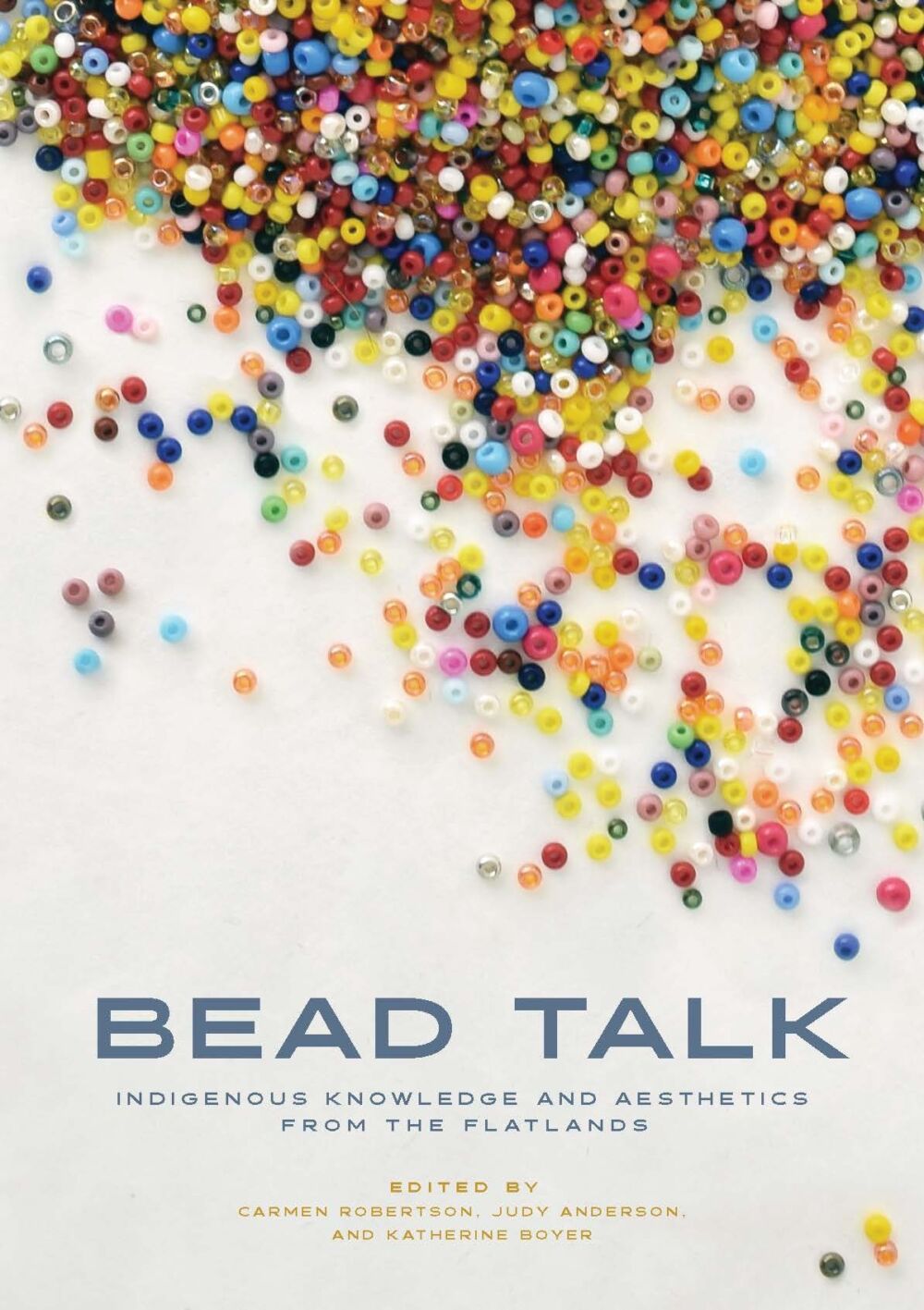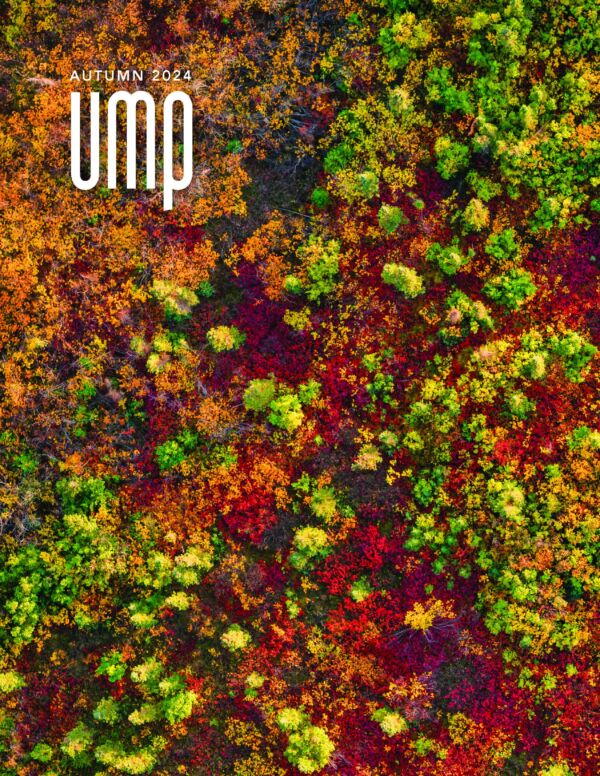“They’re the connectors, they connect all the different constellations, and you bring people together, that’s something that you do.” In the following excerpt from Bead Talk: Indigenous Knowledge and Aesthetics from the Flatlands edited by Carmen L. Robertson, Judy Anderson and Katherine Boyer, artists Dayna Danger and Katherine Boyer discuss their creative practices, queer possibility, and the teaching of spider reciprocity (pages 59–68).

Parallel Lines Move Along Together: A Beaded Line that Connects Me to You
ORIENTATION
In a gesture to honour the work and creative/research journey of Dayna Danger, Katherine Boyer wanted to design, make, and ultimately gift a vest. Our goal through this conversation was to expand on pre-established connections, generate new dialogues related to beading and kinship, and develop a design in a collaborative, mutually consensual manner. The following is the edited conversation recorded at the end of September 2021.
KATHERINE BOYER: So, I am currently working on a vest—I have been doing skies for a little while now, which has a lot of significance for me. It’s this type of knowledge that is underappreciated, and I think it has entirely to do with the future . . . if we understood better what the sky was telling us then we could see what is coming, in a weather-based sense but there is something else to that.
DAYNA DANGER: That makes me think of the Star People and the constellations, those connections, knowing how to navigate space when you look up to the sky even if it’s at night or in the day, it was all indicators of how . . .
KB: Yeah, how to orient yourself, which was another big part of my thought process. The sun tells you where you are and where you’re going. In terms of orientation, that’s a big cornerstone to an LGBTQIA2S+ experience is trying to [orient] yourself and understand the world as you experience it and how the world sees you . . . does that resonate with you?
DD: That is ringing so true for me because I am talking about that erasure, that rupture that severing from those teachings and those connections, especially from being in the city that has kind of numbed me to knowing. When I go home, I can feel it right away, I feel the sky, I feel its presence right away, when you come back to the place where you feel so small and insignificant, there is all of this space above me. What I like about what you’re talking about is the wind. I remember—even my great-great-grandfather would always talk about the [incoming] keewatin, the Northern Wind, then he would know to get out of the fish camp so he could go onto the next task, which was probably tend the farm at this time of season. Even when we were talking about the directions, there are certain things that you know. A wind will always have a certain way . . . somebody was telling me, when you light a fire or match, if you are always pointing your back towards a certain direction, it will always block the wind because it always comes a certain way. Just knowing this, it just seems obvious . . . but people don’t always think about the presence of the wind, and I love what Jas M. Morgan writes in The Prairie Wind is Gay Af: “The prairie wind is gay af. The prairie wind propels the queer body forward in a way shared among queer kin who perpetually followed those sparkling lights on the landscape: that queer lust for the city, that home in the horizon, and that desire for queer possibility.”
SPIDER RECIPROCITY
DD: I think these ideas of reciprocity for Two-Spirit people are huge, especially for us that are Métis, I find that a lot of our queerness is so easily erased. There is the dichotomy of the Métis man and woman and already you’re seen as subhuman because [the term] “Halfbreed” the language around it, the dirtiness of being mixed, I think of Amy Malbeuf ’s work: they were “a little touched with the prairie wolf ”; this derogatory idea of bestiality that is attached to us that is also a projection of sexuality because they know how powerful we are, because we own that shit.
KB: I just attended an online conversation with Kai Pyle [held by the Mamawi Aachimotaak Project] called “Métis, Queer, Trans and Two-Spirit Histories.” It was great to hear some historical accounts of Métis specific experiences . . . these people were defiant and so noteworthy that there are public accounts of them. Several [accounts] were from explorer journals, so the stories definitely have that settler gaze . . .
DD: Even though those accounts are from a gaze that doesn’t understand us, that sees us as different, I have to recognize that that is their perspective, and they are witnessing, and you have to take it with a grain of salt because . . . we were just so part of our communities it just was, we just were happening.
KB: What I [am eventually] hoping to see is [historical] work by the queer or Two-Spirit hand, that is just what I desperately want to find—that is a big want.
DD: It is. But at the same time, it’s not, those are some of the things we are trying to remember. . . . I remember having this moment of being really validated that my family doesn’t have any of our beadwork patterns either. . . . If we talk about working through Spirit and that [type of] remembering with a need to get something out, I just go with that and see what that becomes.
KB: Yeah, I don’t think any idea of visual culture is ever fixed. And I have always let that be a relief for the pressure to do things in a certain way. Because there is no precedent to what we are trying to do today as Métis artists. What I am very grateful to be doing right now is . . . to honour what you do for the Indigenous queer Two-Spirit community, that’s really what I want to be doing here [with this collaboration and gift]. Especially as you go into this PhD mode [in 2022, Dayna began their PhD studies at Concordia University], that’s major research, writing, and idea building.
DD: You know when somebody first shows you how to look for sage and then all of a sudden you keep on seeing sage everywhere. When you put those intentions out there, they start to come back to you. If you’re going to ask for something, there’s reciprocity, you know we have those asema, those tobacco teachings of putting stuff down [on the land] and asking for help and just starting to look around and listen and feel. So many spiders have been coming to me, which is really interesting because I was talking to my mom about it and she said, “They’re the connectors, they connect all the different constellations, and you bring people together, that’s something that you do.”
EXTEND, GIVE, RECEIVE
DD: Maybe part of the process is talking about how we are looking to build our visual cultural language; when that has been severed and disrupted, how do we remember? Spider reciprocity is connecting kin together, and [it is] those lines of connection that we have to each other that builds this larger web. I feel that spider reciprocity is a Two-Spirit teaching because we rely so heavily on making kin with a range of people and across long distances. . . . Art has been the connecting factor to how I find other Two-Spirit community.
KB: One of the things that I think of, which connects art making and lived experiences . . . [is something that was presented by] Hazel Meyer, an artist who has done . . . research in queer world-making and [led me to] this idea of constructing a world when you are faced with one that does not accept you . . . that, to me, is why I do anything. What are your thoughts on that?
DD: I definitely feel that’s something I [rely on]—my imagination and my mind were what I used because this world reflects nothing back to me. When I feel so alone, I create a world where I can exist, because it feels possible. Somebody built this world, so who’s to say that I can’t simultaneously build another reality within this reality. A reality where we exist free of projection, where you can be empowered or objectified, where you get to choose, where you get to have agency in your presentation and in who you are in your being, and it isn’t questioned.

Bead Talk
Indigenous Knowledge and Aesthetics from the Flatlands
Carmen L. Robertson (Editor), Judy Anderson (Editor), Katherine Boyer (Editor)
Beading fosters traditional methods of teaching and learning and enables intergenerational transmissions of pattern and skill. These conversations, interviews, essays, and full-colour reproductions of artwork from expert and emerging artists, academics, and curators from the prairies invite us all into the beading circle.
Posted by U of M Press
February 14, 2024
Categorized as Excerpt
Engraved on Our Nations: Excerpt University of Manitoba Press is hiring a term Editorial Assistant




